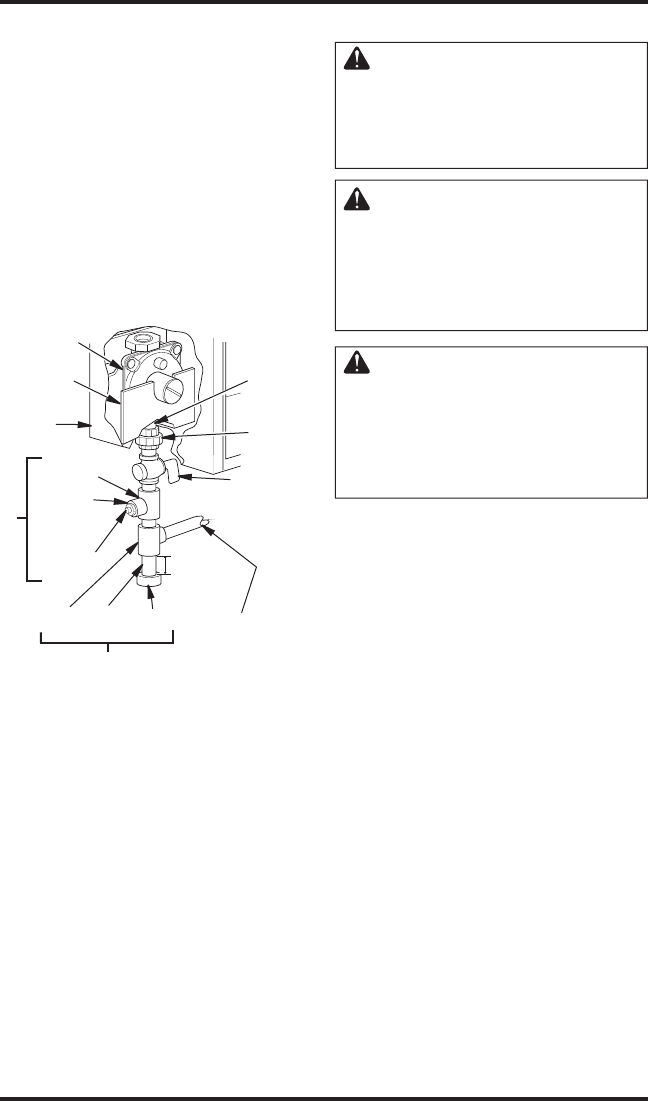
www.desatech.com
11
113261-01A
CHECKING GAS CONNECTIONS
WARNING: Test all gas piping
and connections, internal and
external to unit, for leaks after
installing or servicing. Correct
all leaks at once.
WARNING: Never use an open
flame to check for a leak. Apply
a noncorrosive leak detection
fluid to all joints. Bubbles form
-
ing show a leak. Correct all leaks
at once.
CAUTION: For propane/LP
gas, make sure external regula
-
tor has been installed between
propane/LP supply and heater.
See guidelines under
Connect-
ing to Gas Supply, page 10.
PRESSURE TESTING GAS SUPPLY
PIPING SYSTEM
Test Pressures In Excess Of 1/2 PSIG
(3.5 kPa)
1. Disconnect appliance with its appliance main
gas valve (control valve) and equipment
shutoff valve from gas supply piping system.
Pressures in excess of 1/2 psig (3.5 kPa) will
damage heater regulator.
2. Cap off open end of gas pipe where equipment
shutoff valve was connected.
3. Pressurize supply piping system by either
opening propane/LP supply tank valve for
propane/LP gas or opening main gas valve
located on or near gas meter for natural gas
or using compressed air.
4. Check all joints of gas supply piping system.
Apply a noncorrosive leak detection fluid to
all joints. Bubbles forming show a leak.
5. Correct all leaks at once.
6.
Reconnect heater and equipment shutoff valve to
gas supply. Check reconnected fittings for leaks.
INSTALLATION
Continued
Tee Pipe Cap
Joint Nipple
Tee Joint
Reducer
Bushing to
1/8" NPT
1/8" NPT
Plug Tap
* A CSA design-certified equipment shutoff valve
with 1/8" NPT tap is an acceptable alternative to
test gauge connection. Purchase the optional CSA
design-certified equipment shutoff valve from your
dealer. See
Accessories, page 22.
Figure 13 - Gas Connection
Pressure
Regulator
Test Gauge Connection*
Heater
Cabinet
Sediment Trap
Equipment
Shutoff
Valve *
3"
(76 mm)
Min.
Natural Gas
From Gas Meter
[7" (1.8 kPa) WC to
10.5" (2.6 kPa) WC
Pressure]
Propane/LP
From External Regulator
[11" (2.7 kPa) WC to 14"
(3.5 kPa) WC Pressure]
Regulator
Bracket
Ground
Joint
Union
3/8" NPT
Pipe
Nipple
Install sediment trap in supply line as shown in
Figure 13. Locate sediment trap where it is within
reach for cleaning. Locate sediment trap where
trapped matter is not likely to freeze. A sediment
trap traps moisture and contaminants. This keeps
them from going into heater controls. If sediment
trap is not installed or is installed wrong, heater
may not run properly.
IMPORTANT: Hold the pressure regulator with
wrench when connecting it to gas piping and/or
fittings. Do not over tighten pipe connection to
regulator. The regulator body could be damaged.


















